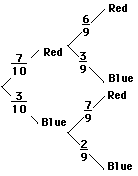|
Q1:
|

What name is given to the type of diagram shown above?
|
A. Bar graph
B. Pie chart
C. Tree diagram
D. Box and
whisker diagram |
Answer 1:
|
|
|
Q2:
|
The diagram in Question 1 shows the probabilities when two coloured balls are drawn from a bag containing 7 red balls and 3 blue balls without replacing the first ball drawn.
What is the probability the first ball is red?
|
A. 
B. 
C.
D.  |
Answer 2:
|
|
|
Q3:
|
Using the diagram in question 1.
Which answer would give the probability that both balls drawn were red?
|
A 
B. 
C. 
D.  |
Answer 3:
|
|
|
Q4:
|
Using the diagram in question 1.
Which answer would give the probability that both balls drawn were blue?
|
A. 
B. 
C. 
D.  |
Answer 4:
|
|
|
Q5:
|
How many branches does the tree diagram have in question 1? |
A. 1
B. 2
C. 3
D. 6 |
Answer 5:
|
|
|
Q6:
|

The above diagram indicates an experiment with how many trials?
|
A. 1
B. 2
C. 3
D. 6 |
Answer 6:
|
|
|
Q7:
|
In the diagram in question 6, what is the probability that the two coins tossed are both heads? |
A. 0.5
B. 0.25
C. 0.2
D. 1 |
Answer 7:
|
|
|
Q8:
|
In the diagram in question 6, what is the probability that the two coins tossed are different ?
|
A. 0.5
B. 0.25
C. 0.2
D. 1 |
Answer 8:
|
|
|
Q9:
|
Complete the set for the sample space for the experiment shown in question 6.
{(H,H), (H,T), (..,...), (T,T)}
|
A. (T, H)
B. (H, T)
C. (H, H)
D. (T, T) |
Answer 9:
|
|
|
Q10:
|
When a six-sided die and a coin are thrown together, what is the probability that a "3" and a "head" result? |
A. 
B. 
C. 
D.  |
Answer 10:
|
|